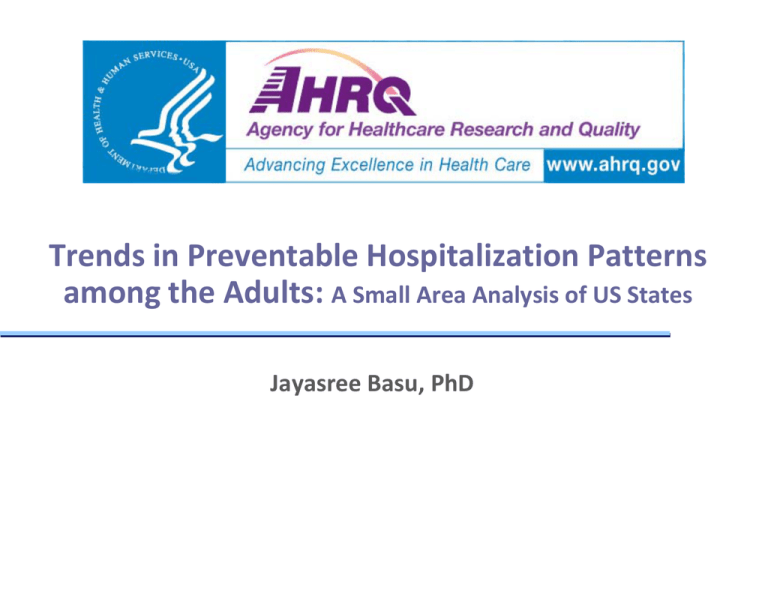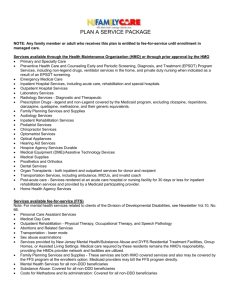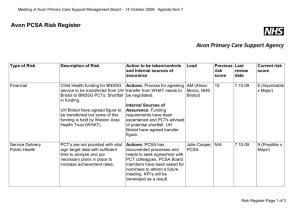Trends in Preventable Hospitalization Patterns among the Adults: among the Adults: A Small Area Analysis of US States
advertisement

Trends in Preventable Hospitalization Patterns among the Adults: A Small Area Analysis of US States among the Adults: A Small Area Analysis of US States Jayasree Basu, PhD Background Access to primary care was largely explored using hospitalizations due Access to primary care was largely explored using hospitalizations due to Ambulatory Care Sensitive Conditions (ACSC) or preventable hospitalizations (PH) TTrends in PH rates in vulnerable patient subgroups over a longer time d i PH i l bl i b l i period remains understudied Such a study provides an overview of how access to primary care has Such a study provides an overview of how access to primary care has changed in the nation The issue is particularly important for the adults since previous research found barriers to access to be the highest among the young hf db i b h hi h h adult and middle aged populations Study Objectives Study Objectives 1 1. To analyze how Ambulatory Care Sensitive Condition (ACSC) rates To analyze how Ambulatory Care Sensitive Condition (ACSC) rates changed over time (1995‐2005): a period marking the beginning and end of several legislative and policy initiatives causing significant changes in the health care market. the health care market. 2. To analyze how ACSC rates varied across small market areas and whether the spatial distribution patterns changed over time 3. To analyze how patient level and contextual factors explain variation in ACSC rates across small areas; and 4. To assess the independent effects of insurance status, supply of primary care, as well as socio‐demographic factors on PH rates over time. Study Design Study Design The unit of analysis = PCSA The unit of analysis = PCSA – A PCSA is the smallest geographic area that can be considered a discrete service area for primary care – Defined on FFS Medicare patient flows to physician offices, updated by HRSA – A PCSA includes a zip code tabulation Area (ZCTA) with one or more primary care providers, and any additional contiguous ZCTAs, whose populations seek their providers, and any additional contiguous ZCTAs, whose populations seek their plurality of primary care from the same providers Census data was aggregated to the PCSA unit: Sociodemographic conditions of the PCSA were computed conditions of the PCSA were computed Compositional factors describing the hospitalized populations in each PCSA (e.g. proportion in PCSA with each type of insurer, proportion by age group mean disease severity race/ethnicity ) were derived age group, mean disease severity, race/ethnicity ) were derived Data STEP 1 Patient‐level hospital discharge data was pulled for 8 states (AZ, CA, OR, WA, MA, MD, NJ, g and NY) for adults (age 18 ‐ 64) Files Used 1995: HCUP SID hospital discharge files (8 states) 2005: HCUP SID hospital discharge files (8 states) STEP 2 Data was aggregated to PCSA level (using patients’ residence zip code) zip code) 1995 and 2005: RTI developed zip code to ZCTA and ZCTA to PCSA cross‐walk files STEP 3 PCSA‐level contextual factors were derived for all 8 states were derived for all 8 states 1995: 1990 Census zip code level data 2005: 2000 census zip code level data 2000 census zip code level data STEP 4 PCSA‐level medical provider d t data were derived d i d 1995: 1990‐1995 ARF data at the county level 2005: 2000‐2005 ARF data at the county level 2000 2005 ARF data at the county level STEP 5 All PCSA‐level variables derived in the earlier steps were merged by matching the PCSAs County level County level data was interpolated to the PCSA level Analysis Descriptive: Hospitalization rates were computed by small areas (i.e. PCSAs) and the mean geographic variations in rate between 1995 and 2005 were examined – PH Rate (Unadjusted) = # PH in a PCSA / # All hospitalizations for patients living in that PCSA – PH Rate (Age‐adjusted) = ∑ (Weight i) * (# PH in PCSA for age i/#All PH R t (A dj t d) ∑ (W i ht i) * (# PH i PCSA f i/#All hospitalizations for age i)); Weights being the proportion of patients of the specific age group living in a PCSA Multivariate: Multivariable models were fitted, one for each year, and M lti i t M lti i bl d l fitt d f h d pooled over two years, to account for relative importance of determinants of preventable admission rates In particular, independent effects of supply of primary care, insurance status, as well as sociodemographic factors on PH rates over time were assessed Descriptive Analysis Descriptive Analysis RESULTS PH Rates: Adults PH Rates: Adults 100 90 80 70 60 50 40 30 20 10 0 1995 2005 AZ CA OR WA MA MD NJ NY All states • Slight decline in PH rates between 1995‐2005 in Northeast (except NJ) • PH rates increased in OR and WA between 1995 and 2005 leading to PH rates increased in OR and WA between 1995 and 2005 leading to an overall increase in PH rates among the Western states No change in PH rates overall • No change in PH rates overall Coefficient of Variation in PH Rates across PCSA: Adults across PCSA: Adults 04 0.4 0.3 1995 0.2 2005 0.1 0 AZ CA OR WA MA MD NJ NY • Small area variation declined between 1995 and 2005 (0.33 to 0.30): • Variation in PH rates HIGHER among adults than elderly Variation in PH rates HIGHER among adults than elderly • Western states had greater variation than Eastern states • CA had greatest % decline between 1995 ‐ CA had greatest % decline between 1995 ‐ 2005 Condition Specific Rates: Adults Condition Specific Rates: Adults ACSC N (1995) N (2005) Rate of Change Unadjusted (age‐adjusted) Immunization‐related 191 231 ( ) 35.05 (20.02) Grand mal status/other epileptic 8681 9901 ‐1.39 (0.90) Convulsion 21318 30523 28.18 (25.87) Severe ENT infection 4972 5049 ‐15.01 (‐12.65) Pulmonary/oth tuberculosis 4047 2248 ‐44.71 (‐45.20) A h Asthma 64318 57407 ‐17.65 (‐20.90) 17 65 ( 20 90) CHF 53154 72180 13.61 (‐1.03) Hypertension 10118 14924 18.10 (10.60) 18.10 (10.60) Angina 37593 13257 ‐67.98 (‐71.74) Cellulitis 42623 70999 55.50 (52.45)) Condition Specific Rates: Adults Condition Specific Rates: Adults ACSC N (1995) N (2005) Rate of Change Unadjusted (age‐adjusted) Diabetes A 20493 29324 ( ) 29.05 (35.85) Diabetes B 13167 21205 42.34 (27.46) Diabetes C 11730 12570 ‐12.12 (‐16.76) Hypoglycemia 686 556 ‐21.76 (‐22.90) Gastroenteritis 17102 18520 ‐8.01 (‐8.89) Kidney/Urinary infection / 33932 41326 5.40 (3.92) ( ) Pelvic inflammatory disease 14808 7960 ‐53.71 (‐49.79) Dental 2944 3709 16 35 (18 56) 16.35 (18.56) Bacterial pneumonia 72832 83165 3.33 (‐5.87) All ACSC 434709 495054 ‐0.13 Highlights: Adults Highlights: Adults Overall Trends Overall Trends o PH rates among adults did not decline overall between 1995‐2005 o Western states had lower PH rate but higher increase than Northeast Western states had lower PH rate but higher increase than Northeast o Small area variation declined between 1995 and 2005 Condition‐Specific Trends o Highest frequency (1) bacterial pneumonia (2) asthma (3) CHF (4) Hi h f (1) b i l i (2) h (3) CHF (4) cellulitis o Highest increase in rates (1) cellulitis (2) diabetes A/B (3) CHF o Highest decline (1) Angina (2) asthma (3) pelvic inflammatory disease. Multivariate Analysis Multivariate Analysis RESULTS Regression Methods Regression Methods Ordinary Least Squares (OLS) regression analysis Adjustment for heteroscedasticity Cross sectional and time series analysis Study population: Adults age 18‐64 Study population: Adults age 18‐64 Dependent variable: Unadjusted all ACSC rate Independent variables: Age (18‐44 yrs; 45‐64 yrs), race (White, AA, Hispanic, other), insurance (Medicaid FFS; Medicaid HMO; Private FFS; Private HMO; Self‐ pay; All other payers), population density, income, average distance to hospitals, rural/urban, and supply factors (like primary care physician capacity, hospital inpatient capacity) Sample Means Sample Means Variable 2005 (n=953) Mean 1995 (n=935) Mean PH admission rates , adults Proportion of adult, 18 to 44 years Proportion of adult, 45 to 64 years 0.087 0.53* 0.47* 0.088 0.61 0.39 Proportion of adult Caucasian discharges Proportion of adult AA discharges Proportion of adult Hispanic discharges Proportion of adult other race discharges 0.69* 0.074 0.15* 0.092 0.72 0.072 0.12 0.088 Proportion of adult, Medicaid FFS Proportion of adult, Medicaid HMO f d l d d Proportion of adult, private FFS Proportion of adult, Private HMO Proportion of adult, self‐pay Proportion of adult, self pay Proportion of adult, all other payers 0.100* 0.05** 0.30* 0.22* 0.05 * 0.05 0.29* 0.21 0.002 0.35 0.19 0.08 0.17 * Shows significant changes between 1995‐2005 (p<0.05) Sample Means Sample Means 2005 (n=953) Variable 1995 (n=934) Mean 51957 * 38265 Hospital inpatient capacity per Hospital inpatient capacity per 1000 population 3688.09 * 890 39 890.39 Average distance from patient zip code to hospital zip code 24.38 24.07 3560.90 3953.36 Primary care physician capacity Primary care physician capacity per 1000 population 0.72** 0.51 Proportion of PCSA that is Rural 0.28 * 0.34 Average income Population density Highlights Factors likely to reduce PH rates: Primary care physician capacity: increased by 41% between 1995 and 2005 with most increase in northeastern states (64%). HMO enrollment: Significant increase in commercial as well as in Medicaid HMO enrollment occurred over the 10 year period. The Northeastern states showed higher growth rates than the West in private as well as Medicaid HMO enrollments. Socioeconomic: Average household income increased by 36% overall. Factors likely to increase PH rates: Uninsured: proportions of uninsured dropped from 8% to 5% . Medicaid FFS enrollment: declined sharply from 21% to 10%, while Private FFS enrollment declined moderately from 35% to 30%. Hospital inpatient capacity: increased with most increase observed in western states Hospital inpatient capacity: increased with most increase observed in western states. Demographic: Age group 45‐64 grew while age group 18‐44 declined and % minorities (e.g. Hispanics) significantly increased. 1995 – 2005 Multivariate Analysis 1995 2005 Multivariate Analysis Variable 1995 (n=934), β 2005 (n=953), β Adults ages 45 to 64 years 0.06889 § 0.08601 § Adults Medicaid HMO ‐0.01159 0.03372 § Adults Medicaid FFS 0.05685 § 0.04627 § Adults private HMO ‐0.0432 § ‐0.011441 Adults uninsured 0.06936 § 0.14987 § Adults other pay Adults other pay 0.03719 § 0.03719 0.04793 § 0.04793 Adults African American 0.06658 § 0.06614 § Adults Hispanic discharges ‐0.02730§ ‐0.000457 Adults other race Adults other race ‐0.01727 0 01727 0 015207 0.015207 Average income ‐0.00000339 § ‐0.000000234 § Hospital inpatient capacity /1000 pop 0.000000641 0.0000000143 Average distance to hospital d h l 0.00000463 ‐0.0.0000666 Population density 0.000000162 0.0000000922 PCP capacity /1000 pop ‐0.017871 § ‐0.0062358 § Proportion of rural 0.0045181 ‐0.006585 § Adjusted R2 0.4345 0.4786 1995 – 2005 Multivariate Analysis WITH STATE FIXED EFFECTS WITH STATE FIXED EFFECTS Variable 1995 (n=934), β 2005 (n=953), β California vs New York ‐0.0178 § ‐0.0087 § Arizona vs A i N Y k New York New Jersey vs New York Massachusetts vs New York ‐0.0084 0 0084 0.0145 § ‐0.0019 ‐0.0186 0 0186 § 0.0189 § ‐0.0015 g y Adults ages 45 to 64 years 0.0705 § 0.0890 § Adults Medicaid HMO Adults Medicaid FFS Adults private HMO Adults uninsured Adults uninsured Adults other pay ‐0.1061 0.1024 § ‐0.0163 0 0234 0.0234 0.0597 § 0.0345 § 0.0803 § ‐0.0122 0 0374 0.0374 0.0609 § Adults African American 0.0487 § 0.0602 § Adults Hispanic discharges Adults Hispanic discharges Adults other race ‐0 0.0213 0213 § ‐0.0278 § 0.0058 0 0058 0.0193 § ‐0.000000516 § ‐0.000000265 § Hospital inpatient capacity /1000 pop p p p y/ p p 0.000000421 0.0000000510 § Average distance to hospital 0.0000378 § ‐0.0000141 Population density 0.000000482 0.000000033 PCP capacity /1000 pop PCP capacity /1000 pop ‐0.0067 0 0067 ‐0.0068 0 0068 § Proportion of rural 0.0017 ‐0.0078 § Adjusted R2 0.4921 Average income 0.5114 1995 – 2005 Multivariate Analysis with Panel data with Panel data Analysis of cross sectional time series panel data using a first l f l ld f difference approach shows that the following variables were significantly associated with PH rates 1995‐2005 Variable Time‐series β Probability Adults uninsured 0.0315 0.039 Hispanic discharges 0.0299 0 .028 Average income 5.57‐07 0.001 African‐American discharges 0.0990 0.000 Inpatient days Inpatient days 7.01‐08 7.01 08 0.002 Adjusted R2 0.0675 Test for Heteroskedasticity 0.0013 Multivariate Analysis Summary: 1995‐2005 Summary: 1995 2005 Factors associated with lower PH rates PCP capacity: increased density but contributions to PH rate significantly dropped in the 10‐year period Private HMO insurance : private HMO shares remained stable and the P i t HMO i i t HMO h i d t bl d th contributions to PH rates significantly dropped in the 10‐year period Medicaid HMO enrollment increased but did not contribute to declining PH admissions (positive association in 2005) admissions (positive association in 2005) Although average income increased, the effect was smaller over time Factors associated with higher PH rates Factors associated with higher PH rates Although proportions of uninsured declined, their contribution to increased PH rates became stronger over the 10‐year interval, particularly in Northeast Medicaid FFS: significant decline in % enrollment and non‐significant decline in per unit contributions. Minority subgroups also increased in relative size and contributions leading to Minority subgroups also increased in relative size and contributions leading to increased PH admissions over time. Adults 45‐64 age‐group increased more than 18‐44 age group, leading to increased PH rates over time Conclusions The adult PH rates did not decline between 1995‐2005 despite policies h d l dd d l b d l to improve access to care This slower than expected decline could be explained by: p p y – stronger influence of minority and uninsured status, relatively stable contribution of managed care enrollment in the – aa relatively stable contribution of managed care enrollment in the commercial market, – weaker association of Medicaid managed care with PH rate reduction. reduction The PCP density had stronger association with reduction in PH rates for adults in 1995 than in 2005 Although average per capita income increased, its per unit contributions to PH reduction did not increase. Acknowledgments Vennela Thumula, U. Mississippi L M bl Ph D R Lee Mobley, Ph.D., Research Triangle Institute h T i l I tit t




